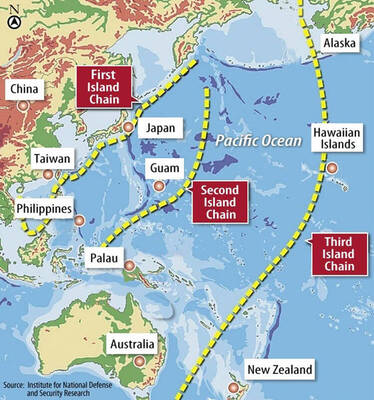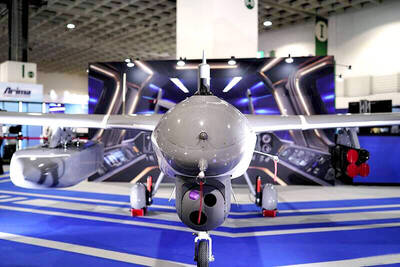Premier Frank Hsieh (
"The government is under a lot of pressure for injecting more money into the project, but it's worth it," Hsieh told reporters after the 15-minute ride. "It would be regrettable to give up on it now."
The train departed from Tainan Station, headed northward to Tainan County's Liouchia (六甲) Township and then south to Dashe (大社) Township in Kaohsiung County before returning to the station.
The Taiwan High-Speed Rail Corp (THSRC), builder of the high-speed rail system, reached its target of running the bullet train at a top speed of 315kph on Oct. 30.
THSRC chairwoman Nita Ing (
"This is a milestone for us," Ing said, adding that her first experience on the train was very good.
Ing said that THSRC will hold a provisional board meeting next week and a shareholder meeting in January -- instead of May -- to discuss the approval of three new board directors representing the government, as required by the Ministry of Transportation and Communications.
THSRC expanded the number of its board directors from 12 to 15 seats last month after the government decided to pump another NT$7.5 billion (US$223 million) into the project. That amount included NT$4.5 billion from the China Aviation Development Foundation and NT$3 billion from China Technical Consultant Inc.
The government currently has two seats in the board but hopes to obtain three more. However, whether the government will be able to occupy the three new seats remains to be negotiated, said Arthur Chiang (江金山), vice president of THSRC's administration division.
The government's holding in THSRC jumped from 11.89 percent to about 37 percent, but 19 percent of that was through purchasing preferred shares, which confer no voting rights, Chiang said.
Ing declined to reveal how much capital the company still needs to complete the project's construction, saying a new fund-raising plan will be released by the middle of the month.
The one-year delay of the project is estimated to cost the company an additional NT$19.3 billion, Chiang said.
Ing announced on Sept. 8 that the firm's board of directors decided to reschedule the opening of the high-speed railway to Oct. 31 next year, blaming delays in the construction of the core mechanical and electrical systems.
THSRC is currently negotiating compensation for the delays with the Taiwan Shinkansen Corp (TSC, 台灣新幹線), contractor for the core system's construction. Yesterday, TSC chairman Takaomi Goto said he hopes the negotiation will be completed by the end of the month.
"I think who should bear the responsibility for the delay is still an open question," Goto told the Taipei Times yesterday.
Becoming familiar with the Japanese-designed bullet train system has taken a lot of time, especially for the THSRC, whose engineers are mostly US and European, Goto said.
Despite the setback in exporting the system for the first time, from a business point of view, the Japanese consortium will still look for other countries in which to introduce the bullet train, Goto added.
The consortium of seven Japanese companies includes Mitsui Corp, Mitsubishi Heavy Industries, Mitsubishi Corp, Marubeni Corp, Sumitomo Corp, Kawasaki Heavy Industries and Toshiba Electric.
As of the end of September, THSRC said it had completed 89.7 percent of the project, according to a company release. The core mechanical and electrical system which THSRC is responsible for is 66 percent completed, while the project's track and station construction are 83 percent and 93.1 percent finished, the release added.
The Tainan station yesterday seemed far from ready to serve customers, with many areas still blocked off.
THSRC plans to test the track in Taoyuan and other areas in the north starting in January, Ing said.

The US government has signed defense cooperation agreements with Japan and the Philippines to boost the deterrence capabilities of countries in the first island chain, a report by the National Security Bureau (NSB) showed. The main countries on the first island chain include the two nations and Taiwan. The bureau is to present the report at a meeting of the legislature’s Foreign Affairs and National Defense Committee tomorrow. The US military has deployed Typhon missile systems to Japan’s Yamaguchi Prefecture and Zambales province in the Philippines during their joint military exercises. It has also installed NMESIS anti-ship systems in Japan’s Okinawa

‘WIN-WIN’: The Philippines, and central and eastern European countries are important potential drone cooperation partners, Minister of Foreign Affairs Lin Chia-lung said Minister of Foreign Affairs Lin Chia-lung (林佳龍) in an interview published yesterday confirmed that there are joint ventures between Taiwan and Poland in the drone industry. Lin made the remark in an exclusive interview with the Chinese-language Liberty Times (the Taipei Times’ sister paper). The government-backed Taiwan Excellence Drone International Business Opportunities Alliance and the Polish Chamber of Unmanned Systems on Wednesday last week signed a memorandum of understanding in Poland to develop a “non-China” supply chain for drones and work together on key technologies. Asked if Taiwan prioritized Poland among central and eastern European countries in drone collaboration, Lin

Renewed border fighting between Thailand and Cambodia showed no signs of abating yesterday, leaving hundreds of thousands of displaced people in both countries living in strained conditions as more flooded into temporary shelters. Reporters on the Thai side of the border heard sounds of outgoing, indirect fire yesterday. About 400,000 people have been evacuated from affected areas in Thailand and about 700 schools closed while fighting was ongoing in four border provinces, said Thai Rear Admiral Surasant Kongsiri, a spokesman for the military. Cambodia evacuated more than 127,000 villagers and closed hundreds of schools, the Thai Ministry of Defense said. Thailand’s military announced that

CABINET APPROVAL: People seeking assisted reproduction must be assessed to determine whether they would be adequate parents, the planned changes say Proposed amendments to the Assisted Reproduction Act (人工生殖法) advanced yesterday by the Executive Yuan would grant married lesbian couples and single women access to legal assisted reproductive services. The proposed revisions are “based on the fundamental principle of respecting women’s reproductive autonomy,” Cabinet spokesperson Michelle Lee (李慧芝) quoted Vice Premier Cheng Li-chiun (鄭麗君), who presided over a Cabinet meeting earlier yesterday, as saying at the briefing. The draft amendment would be submitted to the legislature for review. The Ministry of Health and Welfare, which proposed the amendments, said that experts on children’s rights, gender equality, law and medicine attended cross-disciplinary meetings, adding that